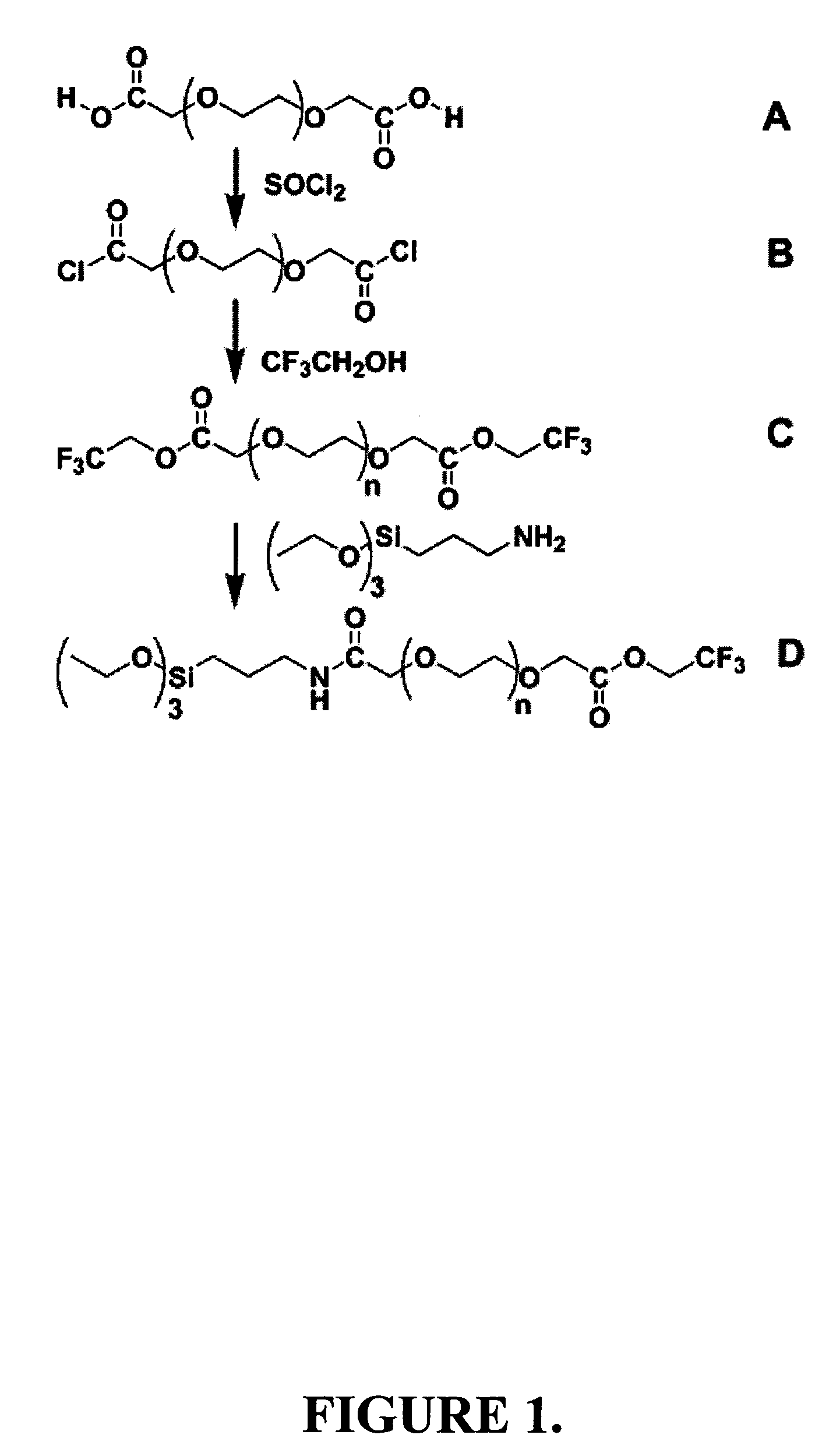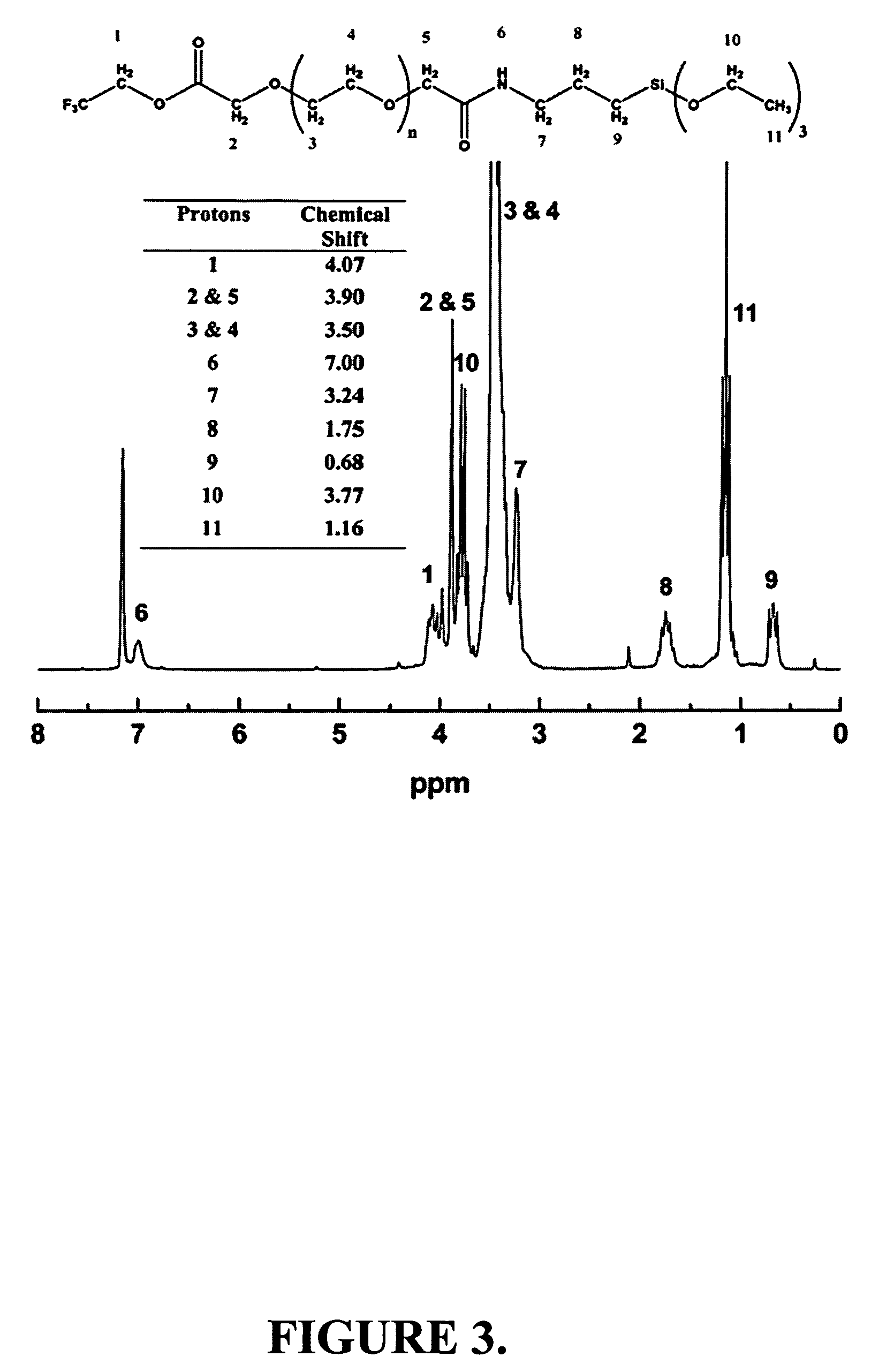Magnetic nanoparticle compositions and methods
a technology of nanoparticles and compositions, applied in the direction of magnetic materials, group 4/14 element organic compounds, magnetic bodies, etc., can solve the problems of gd) complex contrast agents, ineffective resolution of instruments, and high cos
- Summary
- Abstract
- Description
- Claims
- Application Information
AI Technical Summary
Problems solved by technology
Method used
Image
Examples
example 1
Materials and Instrumentation
[0173]Materials.
[0174]The following materials were purchased from Sigma-Aldrich and used as received: PEG biscarboxylate (Mn 600), thionyl chloride, trifluoroethanol, ethylenediamine, 3-aminopropyltriethoxysilane (APS), N-hydroxysuccinimide 97% (NHS), 1-ethyl-3-(3-(dimethylamino)-propyl) carbodiimide (EDAC), iron(III) acetylacetonate, diphenyl ether, oleylamine, oleic acid, folic acid, and tertiarybutoxycarbonyl. Benzene-d6 was purchased from Cambridge Isotopes. All other solvents were purchased from Fisher Scientific (Hampton, N.H.) or Aldrich (Milwaukee, Wis.
[0175]Instrumentation.
[0176]1H NMR spectra were acquired with Varian 300 MHz NMR and Bruker DPX-200 NMR spectrometers equipped with a Spectrospin 4.7 T superconducting magnet.
[0177]FTIR spectra were acquired using a Nicolet 5-DXB FTIR spectrometer with a resolution of 4 cm−1. PEG-silane samples for FTIR analysis were prepared by placing a drop of the liquid between two KBr windows. To analyze the F...
example 2
The Synthesis of a Representative PEG Silane
[0178]In this example, the synthesis of a representative PEG silane of the invention is described. The process and products for each reaction step are shown schematically in FIG. 1.
[0179]In a round-bottom flask, 100 g (0.167 mol) of PEG biscarboxylate was degassed under a 2-Torr vacuum to remove residual water and air in the liquid. Following degassing, 35 mL (0.48 mol) of thionyl chloride was added dropwise to the neat PEG, converting it to the corresponding diacid chloride. Initially, vigorous bubbling was observed followed by slow bubbling resulted from HCl and SO2 gas. The sample was heated for 1.5 h under nitrogen followed by degassing under a 2-Torr vacuum to remove SO2 gas and excess thionyl chloride. The crude diacid chloride displayed the following 1H NMR spectrum: (C6D6) δ4.08 (brm, 4H, ClOCCH2—), 3.4 (brm, 43H, —CH2CH20—).
[0180]Next, 32 mL (0.44 mol) of 2,2,2-trifluoroethanol was added dropwise to the PEG diacid chloride under n...
example 3
The Synthesis of Representative Superparamagnetic Nanoparticles
[0182]In this example, the synthesis of representative superparamagnetic nanoparticles of the invention is described.
[0183]Preparation of Oleyl Nanoparticles.
[0184]Oleyl-nanoparticles were prepared following the method by Sun with modifications. See Sun et al., J Am. Chem. Soc. 2002, 124, 8204-8205, incorporated herein by reference in its entirety.
[0185]First, 20 mL of phenyl ether, 0.728 g of iron (III) acetylacetonate, 2.858 g of 1,2-hexadecanediol, 2.11 mL of oleic acid (0.262 M), and 2.75 mL of oleylamine (0.198 M) were mixed in a sonicated bath. The mixture was slowly heated to 265° C. and refluxed under nitrogen for 30 min. During this process, the initial reddish-orange color of the solution gradually changed to dark black, indicative of formation of the oleyl-magnetite nanoparticles. The resultant solution was cooled to room temperature, and 250 mL ethanol was added to yield a black precipitate. The precipitate w...
PUM
| Property | Measurement | Unit |
|---|---|---|
| particle diameter | aaaaa | aaaaa |
| fluorescent | aaaaa | aaaaa |
| composition | aaaaa | aaaaa |
Abstract
Description
Claims
Application Information
 Login to View More
Login to View More - R&D
- Intellectual Property
- Life Sciences
- Materials
- Tech Scout
- Unparalleled Data Quality
- Higher Quality Content
- 60% Fewer Hallucinations
Browse by: Latest US Patents, China's latest patents, Technical Efficacy Thesaurus, Application Domain, Technology Topic, Popular Technical Reports.
© 2025 PatSnap. All rights reserved.Legal|Privacy policy|Modern Slavery Act Transparency Statement|Sitemap|About US| Contact US: help@patsnap.com



